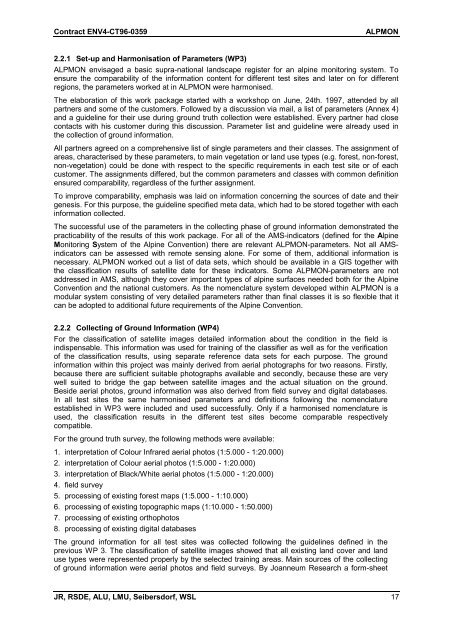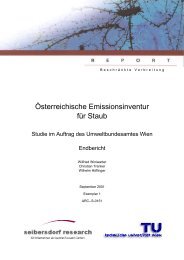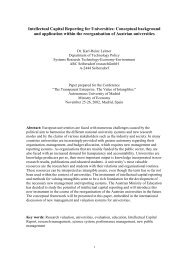ALPMON FINAL REPORT - ARC systems research
ALPMON FINAL REPORT - ARC systems research
ALPMON FINAL REPORT - ARC systems research
You also want an ePaper? Increase the reach of your titles
YUMPU automatically turns print PDFs into web optimized ePapers that Google loves.
Contract ENV4-CT96-0359 <strong>ALPMON</strong><br />
2.2.1 Set-up and Harmonisation of Parameters (WP3)<br />
<strong>ALPMON</strong> envisaged a basic supra-national landscape register for an alpine monitoring system. To<br />
ensure the comparability of the information content for different test sites and later on for different<br />
regions, the parameters worked at in <strong>ALPMON</strong> were harmonised.<br />
The elaboration of this work package started with a workshop on June, 24th. 1997, attended by all<br />
partners and some of the customers. Followed by a discussion via mail, a list of parameters (Annex 4)<br />
and a guideline for their use during ground truth collection were established. Every partner had close<br />
contacts with his customer during this discussion. Parameter list and guideline were already used in<br />
the collection of ground information.<br />
All partners agreed on a comprehensive list of single parameters and their classes. The assignment of<br />
areas, characterised by these parameters, to main vegetation or land use types (e.g. forest, non-forest,<br />
non-vegetation) could be done with respect to the specific requirements in each test site or of each<br />
customer. The assignments differed, but the common parameters and classes with common definition<br />
ensured comparability, regardless of the further assignment.<br />
To improve comparability, emphasis was laid on information concerning the sources of date and their<br />
genesis. For this purpose, the guideline specified meta data, which had to be stored together with each<br />
information collected.<br />
The successful use of the parameters in the collecting phase of ground information demonstrated the<br />
practicability of the results of this work package. For all of the AMS-indicators (defined for the Alpine<br />
Monitoring System of the Alpine Convention) there are relevant <strong>ALPMON</strong>-parameters. Not all AMSindicators<br />
can be assessed with remote sensing alone. For some of them, additional information is<br />
necessary. <strong>ALPMON</strong> worked out a list of data sets, which should be available in a GIS together with<br />
the classification results of satellite date for these indicators. Some <strong>ALPMON</strong>-parameters are not<br />
addressed in AMS, although they cover important types of alpine surfaces needed both for the Alpine<br />
Convention and the national customers. As the nomenclature system developed within <strong>ALPMON</strong> is a<br />
modular system consisting of very detailed parameters rather than final classes it is so flexible that it<br />
can be adopted to additional future requirements of the Alpine Convention.<br />
2.2.2 Collecting of Ground Information (WP4)<br />
For the classification of satellite images detailed information about the condition in the field is<br />
indispensable. This information was used for training of the classifier as well as for the verification<br />
of the classification results, using separate reference data sets for each purpose. The ground<br />
information within this project was mainly derived from aerial photographs for two reasons. Firstly,<br />
because there are sufficient suitable photographs available and secondly, because these are very<br />
well suited to bridge the gap between satellite images and the actual situation on the ground.<br />
Beside aerial photos, ground information was also derived from field survey and digital databases.<br />
In all test sites the same harmonised parameters and definitions following the nomenclature<br />
established in WP3 were included and used successfully. Only if a harmonised nomenclature is<br />
used, the classification results in the different test sites become comparable respectively<br />
compatible.<br />
For the ground truth survey, the following methods were available:<br />
1. interpretation of Colour Infrared aerial photos (1:5.000 - 1:20.000)<br />
2. interpretation of Colour aerial photos (1:5.000 - 1:20.000)<br />
3. interpretation of Black/White aerial photos (1:5.000 - 1:20.000)<br />
4. field survey<br />
5. processing of existing forest maps (1:5.000 - 1:10.000)<br />
6. processing of existing topographic maps (1:10.000 - 1:50.000)<br />
7. processing of existing orthophotos<br />
8. processing of existing digital databases<br />
The ground information for all test sites was collected following the guidelines defined in the<br />
previous WP 3. The classification of satellite images showed that all existing land cover and land<br />
use types were represented properly by the selected training areas. Main sources of the collecting<br />
of ground information were aerial photos and field surveys. By Joanneum Research a form-sheet<br />
JR, RSDE, ALU, LMU, Seibersdorf, WSL 17




